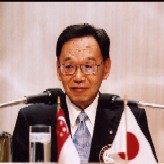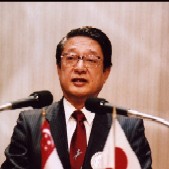Initiation Speech
January 24, 2007
Mr. Tsuneo Moriya
Mr. Kinju Atarashi
 Mr. Tsuneo Moriya,
Mr. Tsuneo Moriya,
Chairman of the Board of Directors,
Sumitomo Bakelite Company, Ltd.
��Contribution of Plastics to the Development of the Society��
The business of Sumitomo Bakelite Company, Ltd. is to synthesize plastics and add various functions to plastics and also to supply plastics to a wide range of industries. At present, plastics covers a vast area in science as well as in industry. Our company covers only a part of the plastic industry, and I hope you will understand that my speech will cover only one segment of the science and industry of plastics.
The word plastics comes from the Greek word ��Plastikos��. In Japanese, it is called Gosei Jyushi and it is defined in JIS(ISO) ��A material which contains as an essential ingredient a high polymer and which at some stage in its processing into finished products can be shaped by flow.��
Plastics can be divided into two categories, namely thermosetting and thermoplastic.
The beginning of plastics is phenol resin with thermosetting characteristics. In 1907, one hundred years ago, the first plastic was made by Dr. Bakeland, a Belgium born American, using the trade name of Bakelite. In Japan, the production of Bakelite started in 1911 recieving license from Dr. Bakeland, by the effort of Dr. Jyokichi Takamine, who was a friend of Dr. Bakeland, and the business was succeeded by Nippon Bakelite, which is now Sumitomo Bakelite.
By responding to the needs of the society, various technological developments were made, and plastics of various characteristics were invented, and the use and consumption of plastics developed vastly, while overcoming various social problems caused in the process. At present, there are 103 kinds of plastics registered in JIS. While new uses are developed by the invention of new plastics, phenol plastic which was industrialized 100 years ago has been continuously renewed and is now widely used for the reduction of the weight of automobile and other uses.
Here are statistics to show the world production of plastics and steel from 1950 to 2004. The production of plastics has increased every year and has reached to 224 million tons in 2004, which is one fifth of steel production of 1,060 million tons. But by volume, the production of plastics was 224 billion liters which is higher than the production of steel which was 133 billion liters in 2004. Plastic is produced mainly from crude oil. You may think that producing plastics uses lots of crude oil, a limited resource. But this is not true. According to statistics of 2003 of the Petrochemical Industry Association, plastics use only 6.3% of all the import of crude oil and naphtha. Also the use of crude oil to produce plastics is only 2.66 liters for one liter of polycarbonate, which consumes a relatively high volume of crude oil among the various plastics. Compare this with steel which requires 3.78 liters of crude oil for one liter of production. Though plastics are an excellent raw material, there are still issues to overcome to meet the progress of society. It is necessary to improve the effective use of limited resources, to improve the safety of the products and to pay more attention to the effects on the environment. The widening of the source of raw material is also necessary.
As a man involved in the plastics industry, I wish to do my best to playing a part in solving the above issues as much as possible.
 Mr. Kinju Atarashi,
Mr. Kinju Atarashi,
Executive Vice President,
The Japan Atomic Power Co. Ltd.
��The Topics on Nuclear Power Generation��
Right now in the world, a positive re-evaluation of nuclear power, ��Nuclear Renaissance�� is taking place. In the United States, about 30 new nuclear power plants are now under planning with the strong back up of the government, and in Europe, new construction projects are developing in Finland and France. England re-evaluated its energy policy to consider the new building of nuclear power plants. Furthermore, China, India, Indonesia, Vietnam, Australia, Kazakhstan, Egypt, and even six Gulf states are planning or showing an interest in nuclear power generation.
There are two reasons for such movements.
Firstly, serious concerns of securing energy supply. While demand of oil in China, India, and other countries sharply increased, the supply of oil is expected to become tight in the mid and long term. Most countries have become very sensitive to the energy security. And this leads to the re-evaluation of nuclear power, which is non fossil energy.
The second factor is concern for environmental issues. In order to control the emission of carbon dioxide which causes global warming, wind-power and solar power have been introduced, but it is recognized that they still have some problems in stability of supply and efficiency, therefore nuclear power comes to attract the attention again.
In Japan, there are 55 nuclear power generation plants, with the capacity of about 50 thousand MW, and nuclear electric power generation accounts for one third of total electric power generation in Japan. The Japanese economy is not much influenced by the recent increase of oil prices, and this is because of the fact that after the experience of two Oil Shocks, Japan has positively introduced nuclear power as well as oil stockpiles and extensive energy conservation.
In these two years, the Japanese government decided new nuclear power policy titled as ��Framework for Nuclear Energy Policy�� and ��Japan��s Nuclear Energy National Plan��. The policy of propelling the use of nuclear power was reconfirmed by these decisions and the following were set as national targets.
Beyond 2030, nuclear power generation in Japan will continue to account for at least 30-40 percent of total power generation.
The nuclear fuel cycle must be steadily promoted.
In this process, a new movement for the construction of new and additional nuclear power plants has started.
As for the fast breeder reactor, Monjyu, the prototype reactor, has been out of operation for a long time, but operation is expected to resume next year with the understanding of the local residents. According to ��Japan��s Nuclear Energy National Plan�� the establishment of the demonstration reactor is forecasted in around 2025, and the goal of the commercialization to is set in 2050 or earlier.
I should like to explain three important issues with regards to the promotion of nuclear power henceforth.
First is Assurance of Safety. People engaged in nuclear power sincerely recognize the importance of Safety First, but, these days, it is important to gain Public��s Trust in addition to Safety. In this respect, we have to seriously regret the fact that in some cases information data were concealed or altered, which caused public distrust, and we must continue to make our best efforts to obtain the confidence of the public by means of more information disclosure.
Second is Disposal of high level radioactive waste. Regarding the high level radioactive waste, the policy direction is already decided to dispose it in a deep underground repository after being vitrified.
However, the site for the repository has not been decided yet. The candidate site will be chosen by Open Solicitation to municipalities, and the Nuclear Waste Management Organization is handling the matter. However it is necessary that all the people concerned should do their best for a successful solution.
Third is Utilization of Nuclear Energy strictly for Peaceful Purposes. After North Korea��s experiment of nuclear weapons, we hear some opinions that Japan should also possess nuclear weapons. But possession of nuclear weapons means secession from the NPT mechanism, which is centred on the Nuclear Non-Proliferation Treaty. This will lead to Japan to the stoppage of uranium supply, which will cause crucial difficulties for the peaceful utilization of nuclear energy in Japan. I believe Japan should not take this course of action.